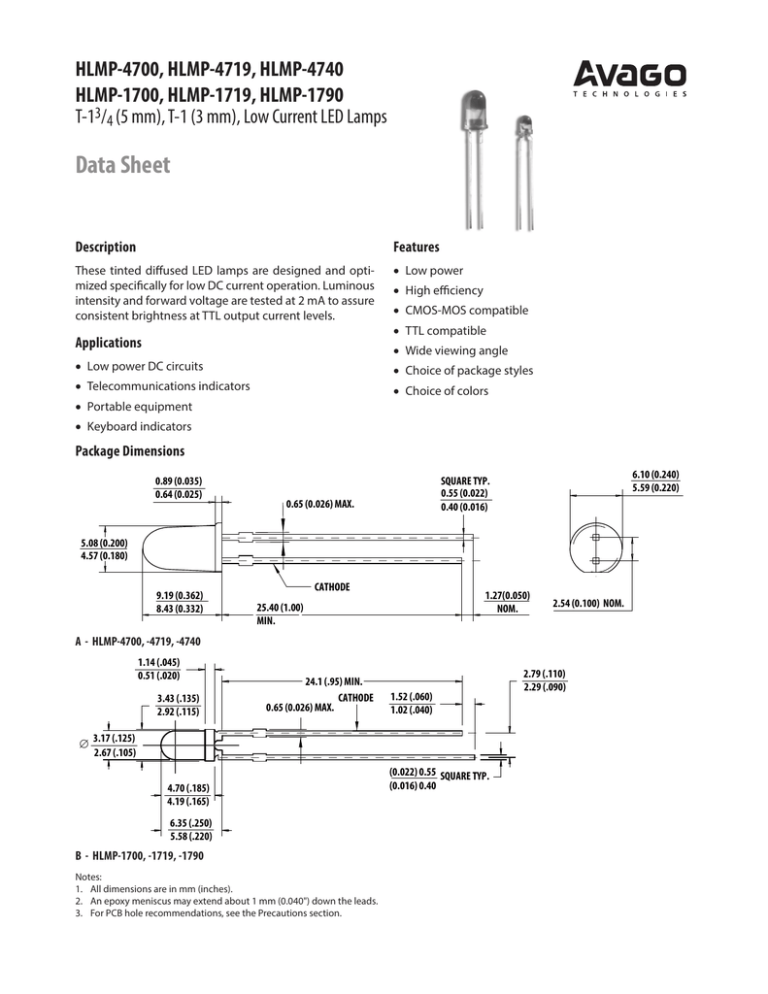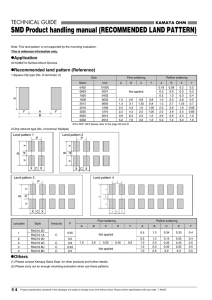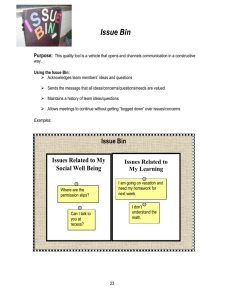
HLMP-4700, HLMP-4719, HLMP-4740
HLMP-1700, HLMP-1719, HLMP-1790
T-13/4 (5 mm), T-1 (3 mm), Low Current LED Lamps
Data Sheet
Description
Features
These tinted diffused LED lamps are designed and optimized specifically for low DC current operation. Luminous
intensity and forward voltage are tested at 2 mA to assure
consistent brightness at TTL output current levels.
• Low power
Applications
• High efficiency
• CMOS-MOS compatible
• TTL compatible
• Wide viewing angle
• Low power DC circuits
• Choice of package styles
• Telecommunications indicators
• Choice of colors
• Portable equipment
• Keyboard indicators
Package Dimensions
0.89 (0.035)
0.64 (0.025)
6.10 (0.240)
5.59 (0.220)
SQUARE TYP.
0.55 (0.022)
0.40 (0.016)
0.65 (0.026) MAX.
5.08 (0.200)
4.57 (0.180)
9.19 (0.362)
8.43 (0.332)
CATHODE
1.27(0.050)
NOM.
25.40 (1.00)
MIN.
2.54 (0.100) NOM.
A - HLMP-4700, -4719, -4740
1.14 (.045)
0.51 (.020)
3.43 (.135)
2.92 (.115)
∅
24.1 (.95) MIN.
CATHODE
0.65 (0.026) MAX.
1.52 (.060)
1.02 (.040)
3.17 (.125)
2.67 (.105)
4.70 (.185)
4.19 (.165)
6.35 (.250)
5.58 (.220)
B - HLMP-1700, -1719, -1790
Notes:
1. All dimensions are in mm (inches).
2. An epoxy meniscus may extend about 1 mm (0.040") down the leads.
3. For PCB hole recommendations, see the Precautions section.
(0.022) 0.55 SQUARE TYP.
(0.016) 0.40
2.79 (.110)
2.29 (.090)
Selection Guide
Package Description
Color
Device
HLMP-
T-1 3/4 Tinted Diffused
Red
Yellow
Green
T-1 Tinted Diffused
Red
Yellow
Green
Luminous Intensity Iv (mcd) at 2 mA
Min.
Typ.
Max.
2q1/2
Package
Outline
4700
1.5
2.3
–
50
A
4700-C00xx
1.5
2.3
–
4700-CD0FH
1.5
2.3
4.2
4719
0.9
2.1
–
4719-A00xx
0.9
2.1
–
4740
1.0
2.3
–
4740-A00xx
1.0
2.3
–
4740-AB000
1.0
2.3
3.2
1700
0.8
2.1
–
50
B
1700-B00xx
0.8
2.1
–
1719
0.9
2.1
–
1719-A00xx
0.9
2.1
–
1719-ABB00
0.9
2.1
2.8
1790
1.0
2.3
–
1790-A00xx
1.0
2.3
–
1790-AB0FH
1.0
2.4
3.2
Note:
1. q1/2 is the typical off-axis angle at which the luminous intensity is half the axial luminous intensity.
2
Part Numbering System
HLMP – X 7 XX - X X X XX
Mechanical Option
00: Bulk
01: Tape & Reel, Crimped Leads
02, BH: Tape & Reel, Straight Leads
A1, B1: Right Angle Housing, Uneven Leads
A2, B2: Right Angle Housing, Even Leads
FH: 2 Iv bins select with Inventory Control
Color Bin Options
0: Full color bin distribution
B: Color bins 2 & 3 only
Maximum Iv Bin Options
0: Open (No. max. limit)
Others: Please refer to the Iv bin Table
Minimum Iv Bin Options
Please refer to the Iv Bin Table
Color Options
00: GaP HER
19: GaP Yellow
40: GaP Green
90: GaP Green
Package Options
4: T-13/4 (5 mm)
1: T-1 (3 mm)
3
Electrical/Optical Characteristics at TA = 25°C
Symbol
Description
T-13/4
T-1
VF
Forward Voltage
4700
VR
Reverse Breakdown
Voltage
ld
Dl1/2
tS
C
RqJ-PIN
lPEAK
hV
Min.
Typ.
Max.
Units
Test Conditions
1700
1.7
2.0
V
2 mA
4719
1719
1.8
2.5
4740
1790
1.9
2.2
4700
1700
5.0
V
IR = 50 μA
nm
Note 1
4719
1719
5.0
4740
1790
5.0
Dominant
4700
1700
626
Wavelength
4719
1719
585
4740
1790
569
Spectral Line
4700
1700
40
Halfwidth
4719
1719
36
4740
1790
28
4700
1700
90
4719
1719
90
4740
1790
500
4700
1700
11
4719
1719
15
4740
1790
18
4700
1700
260[3]
4719
1719
290[4]
4740
1790
4700
1700
635
4740
1790
565
4700
1700
145
4719
1719
500
4740
1790
595
Speed of Response
Capacitance
Thermal Resistance
Peak Wavelength
Luminous Efficacy
nm
ns
pF
VF = 0,
f = 1 MHz
°C/W
Junction to Cathode
Lead
nm
Measurement at Peak
lumens/watt
Note 2
Notes:
1. The dominant wavelength, ld, is derived from the CIE chromaticity diagram and represents the single wavelength which defines the color of the
device.
2. The radiant intensity, Ie, in watts per steradian, may be found from the equation Ie = IV/hV, where IV is the luminous intensity in candelas and hV is
luminous efficacy in lumens/watt.
3. T-13/4.
4. T-1.
4
Absolute Maximum Ratings
Parameter
Maximum Rating
Units
14
17.5
15.4
mW
DC and Peak Forward Current
7
mA
Transient Forward Current (10 μs Pulse)[1]
500
mA
Reverse Voltage (IR = 50 μA)
5.0
V
-40 to 100
-20 to 100
°C
°C
-40 to +100
°C
Power Dissipation
(Derate linearly from 92°C at 1.0 mA/°C)
Red
Yellow
Green
Operating Temperature Range
Red/Yellow
Green
Storage Temperature Range
Notes:
1. The transient peak current is the maximum non-recurring peak current the devices can withstand without damaging the LED die and wire bonds.
It is not recommended that the device be operated at peak currents beyond the Absolute Maximum Peak Forward Current.
1.0
T A = 25° C
RELATIVE INTENSITY
GREEN
YELLOW
RED
0.5
0
500
550
600
650
WAVELENGTH – nm
700
750
Figure 1. Relative intensity vs. wavelength.
10.0
RELATIVE LUMINOUS INTENSITY
(NORMALIZED AT 2mA)
10
DC CURRENT – mA
8
RED
6
YELLOW
GREEN
4
2
0
0
0.5
1.0
1.5
VOLTAGE – V
Figure 2. Forward current vs. forward voltage.
5
2.0
2.5
TA - 25°C
8.0
YELLOW
6.0
GREEN
4.0
RED
2.0
0
0
2
4
6
8
IDC -DC CURRENT PER LED - mA
Figure 3. Relative luminous intensity vs. forward current.
10
10°
0°
1.0
20°
0°
10°
1.0
30°
40°
40°
0.6
60°
0.4
70°
RELATIVE INTENSITY
0.8
50°
0.2
80°
0.0
10° 20° 30° 40° 50° 60° 70° 80° 90° 100°
90°
0.8
50°
0.6
60°
0.4
70°
RELATIVE INTENSITY
20°
30°
0.2
80°
0.0
10° 20° 30° 40° 50° 60° 70° 80° 90° 100°
90°
Figure 4. Relative luminous intensity vs. angular displacement for T-13/4 lamp.
Figure 5. Relative llluminous intensity vs. angular displacement for T-1 lamp.
Intensity Bin Limits
Intensity Bin Limits
Intensity Range (mcd)
Intensity Range (mcd)
Color
Bin
Min.
Max.
Color
Bin
Min.
Max.
Red
B
0.9
1.5
Yellow
A
1.0
1.6
C
1.5
2.4
B
1.6
2.5
D
2.4
3.8
C
2.5
4.0
E
3.8
6.1
D
4.0
6.5
F
6.1
9.7
E
6.5
10.3
G
9.7
15.5
F
10.3
16.6
H
15.5
24.8
G
16.6
26.5
I
24.8
39.6
H
26.5
42.3
J
39.6
63.4
I
42.3
67.7
K
63.4
101.5
J
67.7
108.2
L
101.5
162.4
K
108.2
173.2
M
162.4
234.6
L
173.2
250.0
N
234.6
340.0
M
250.0
360.0
O
340.0
540.0
N
360.0
510.0
P
540.0
850.0
O
510.0
800.0
Q
850.0
1200.0
P
800.0
1250.0
R
1200.0
1700.0
Q
1250.0
1800.0
S
1700.0
2400.0
R
1800.0
2900.0
T
2400.0
3400.0
S
2900.0
4700.0
U
3400.0
4900.0
T
4700.0
7200.0
V
4900.0
7100.0
U
7200.0
11700.0
W
7100.0
10200.0
V
11700.0
18000.0
X
10200.0
14800.0
W
18000.0
27000.0
Y
14800.0
21400.0
Z
21400.0
30900.0
Maximum tolerance for each bin limit is ±18%.
6
Maximum tolerance for each bin limit is ±18%.
Intensity Bin Limits
Color Categories
Intensity Range (mcd)
Color
Bin
Min.
Max.
Green
A
1.1
B
Lambda (nm)
Color
Category #
Min.
Max.
1.8
6
561.5
564.5
1.8
2.9
5
564.5
567.5
C
2.9
4.7
4
567.5
570.5
D
4.7
7.6
3
570.5
573.5
E
7.6
12.0
2
573.5
576.5
F
12.0
19.1
1
582.0
584.5
G
19.1
30.7
3
584.5
587.0
H
30.7
49.1
2
587.0
589.5
I
49.1
78.5
4
589.5
592.0
J
78.5
125.7
5
592.0
593.0
K
125.7
201.1
L
201.1
289.0
M
289.0
417.0
N
417.0
680.0
O
680.0
1100.0
P
1100.0
1800.0
Q
1800.0
2700.0
R
2700.0
4300.0
S
4300.0
6800.0
T
6800.0
10800.0
U
10800.0
16000.0
V
16000.0
25000.0
W
25000.0
40000.0
Green
Yellow
Tolerance for each bin limit is ±0.5 nm.
Maximum tolerance for each bin limit is ±18%.
Mechanical Option Matrix
Mechanical Option Code
Definition
00
Bulk Packaging, minimum increment 500 pc/bag
01
Tape & Reel, crimped leads, min. increment 1300 pcs/bag for T-1 3/4, 1800 pcs/bag for T-1
02
Tape & Reel, straight leads, min. increment 1300 pcs/bag for T-1 3/4, 1800 pcs/bag for T-1
A1
T-1, Right Angle Housing, uneven leads, minimum increment 500 pcs/bag
A2
T-1, Right Angle Housing, even leads, minimum increment 500 pcs/bag
B1
T-1 3/4, Right Angle Housing, uneven leads, minimum increment 500 pcs/bag
B2
T-1 3/4, Right Angle Housing, even leads, minimum increment 500 pcs/bag
BH
T-1, Tape & Reel, straight leads, minimum increment 2000 pcs/bag
FH
Devices that require inventory control and 2 Iv bin select
R1
Tape & Reel, crimped leads, reeled counter clockwise, cathode lead leaving the reel first
Notes: All categories are established for classification of products. Products may not be available in all categories. Please contact your local Avago
representative for further clarification/information.
7
Precautions:
Lead Forming:
• The leads of an LED lamp may be preformed or cut to
length prior to insertion and soldering on PC board.
• For better control, it is recommended to use proper
tool to precisely form and cut the leads to applicable
length rather than doing it manually.
• If manual lead cutting is necessary, cut the leads after
the soldering process. The solder connection forms a
mechanical ground which prevents mechanical stress
due to lead cutting from traveling into LED package.
This is highly recommended for hand solder operation,
as the excess lead length also acts as small heat sink.
Soldering and Handling:
• Care must be taken during PCB assembly and soldering
process to prevent damage to the LED component.
• LED component may be effectively hand soldered
to PCB. However, it is only recommended under
unavoidable circumstances such as rework. The closest
manual soldering distance of the soldering heat source
(soldering iron’s tip) to the body is 1.59mm. Soldering
the LED using soldering iron tip closer than 1.59mm
might damage the LED.
1.59 mm
• ESD precaution must be properly applied on the
soldering station and personnel to prevent ESD
damage to the LED component that is ESD sensitive.
Do refer to Avago application note AN 1142 for details.
The soldering iron used should have grounded tip to
ensure electrostatic charge is properly grounded.
• Recommended soldering condition:
Wave Manual Solder Soldering[1],[2]Dipping
Pre-heat Temperature 105°C Max.
–
Pre-heat Time
60 sec Max.
–
Peak Temperature
250°C Max.
260°C Max.
Dwell Time
3 sec Max.
5 sec Max.
Note:
1) Above conditions refers to measurement with thermocouple
mounted at the bottom of PCB.
2) It is recommended to use only bottom preheaters in order to
reduce thermal stress experienced by LED.
• Wave soldering parameters must be set and maintained
according to the recommended temperature and dwell
time. Customer is advised to perform daily check on the
soldering profile to ensure that it is always conforming
to recommended soldering conditions.
Note:
1. PCB with different size and design (component density) will have
different heat mass (heat capacity). This might cause a change in
temperature experienced by the board if same wave soldering
setting is used. So, it is recommended to re-calibrate the soldering
profile again before loading a new type of PCB.
2. Customer is advised to take extra precaution during wave soldering
to ensure that the maximum wave temperature does not exceed
250°C and the solder contact time does not exceeding 3sec. Overstressing the LED during soldering process might cause premature
failure to the LED due to delamination.
• Any alignment fixture that is being applied during
wave soldering should be loosely fitted and should
not apply weight or force on LED. Non metal material
is recommended as it will absorb less heat during wave
soldering process.
• At elevated temperature, LED is more susceptible to
mechanical stress. Therefore, PCB must allowed to cool
down to room temperature prior to handling, which
includes removal of alignment fixture or pallet.
• If PCB board contains both through hole (TH) LED and
other surface mount components, it is recommended
that surface mount components be soldered on the
top side of the PCB. If surface mount need to be on the
bottom side, these components should be soldered
using reflow soldering prior to insertion the TH LED.
• Recommended PC board plated through holes (PTH)
size for LED component leads.
LED Component
Lead Size
Diagonal
Plated ThroughHole Diameter
Lead size (typ.) 0.45 × 0.45 mm
(0.018 × 0.018 in.)
0.636 mm
(0.025 in)
0.98 to 1.08 mm
(0.039 to 0.043 in)
Dambar shear- 0.65 mm
off area (max.) (0.026 in)
0.919 mm
(0.036 in)
Lead size (typ.) 0.50 × 0.50 mm
(0.020 × 0.020 in.)
0.707 mm
(0.028 in)
Dambar shear- 0.70 mm
off area (max.) (0.028 in)
0.99 mm
(0.039 in)
1.05 to 1.15 mm
(0.041 to 0.045 in)
Note: Refer to application note AN1027 for more information on
soldering LED components.
• Over-sizing the PTH can lead to twisted LED after
clinching. On the other hand under sizing the PTH can
cause difficulty inserting the TH LED.
Refer to application note AN5334 for more information
about soldering and handling of TH LED lamps.
8
Example of Wave Soldering Temperature Profile for TH LED
250
Recommended solder:
Sn63 (Leaded solder alloy)
SAC305 (Lead free solder alloy)
LAMINAR
HOT AIR KNIFE
TURBULENT WAVE
Flux: Rosin flux
Solder bath temperature:
245°C± 5°C (maximum peak temperature = 250°C)
TEMPERATURE (°C)
200
Dwell time: 1.5 sec – 3.0 sec (maximum = 3sec)
150
Note: Allow for board to be sufficiently cooled to
room temperature before exerting mechanical force.
Recommended solder:
Sn63 (Leaded solder alloy)
SAC305 (Lead free solder alloy)
100
Flux: Rosin flux
Solder bath temperature:
245°C± 5°C (maximum peak temperature = 250°C)
50
PREHEAT
0
10
20
30
Dwell time: 1.5 sec – 3.0 sec (maximum = 3sec)
40
50
60
TIME (SECONDS)
70
80
90
100 Note: Allow for board to be sufficiently cooled to
Packaging Label:
(i) Avago Mother Label: (Available on packaging box of ammo pack and shipping box)
(1P) Item: Part Number
STANDARD LABEL LS0002
RoHS Compliant
e3
max temp 250C
(1T) Lot: Lot Number
(Q) QTY: Quantity
LPN:
CAT: Intensity Bin
(9D)MFG Date: Manufacturing Date
BIN: Color Bin
(P) Customer Item:
(V) Vendor ID:
(9D) Date Code: Date Code
DeptID:
Made In: Country of Origin
Lamps Baby Label
(1P) PART #: Part Number
RoHS Compliant
e3
max temp 250C
(1T) LOT #: Lot Number
9
(9D)MFG DATE: Manufacturing Date
QUANTITY: Packing Quantity
room temperature before exerting mechanical force.
DeptID:
Made In: Country of Origin
(ii) Avago Baby Label (Only available on bulk packaging)
Lamps Baby Label
(1P) PART #: Part Number
RoHS Compliant
e3
max temp 250C
(1T) LOT #: Lot Number
(9D)MFG DATE: Manufacturing Date
QUANTITY: Packing Quantity
C/O: Country of Origin
Customer P/N:
CAT: Intensity Bin
Supplier Code:
BIN: Color Bin
DATECODE: Date Code
For product information and a complete list of distributors, please go to our web site:
www.avagotech.com
Avago, Avago Technologies, and the A logo are trademarks of Avago Technologies in the United States and other countries.
Data subject to change. Copyright © 2005-2014 Avago Technologies. All rights reserved. Obsoletes 5989-4256EN
AV02-1557EN - July 24, 2014



